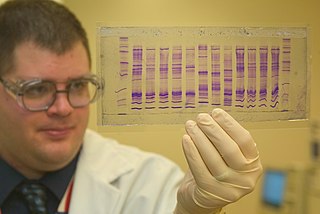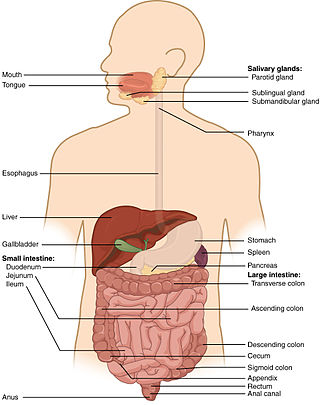
Blood alcohol content (BAC), also called blood alcohol concentration or blood alcohol level, is a measurement of alcohol intoxication used for legal or medical purposes.

Clinical chemistry is a division in medical laboratory sciences focusing on qualitative tests of important compounds, referred to as analytes or markers, in bodily fluids and tissues using analytical techniques and specialized instruments. This interdisciplinary field includes knowledge from medicine, biology, chemistry, biomedical engineering, informatics, and an applied form of biochemistry.

Zopiclone, sold under the brand name Imovane among others, is a nonbenzodiazepine used to treat difficulty sleeping. Zopiclone is molecularly distinct from benzodiazepine drugs and is classed as a cyclopyrrolone. However, zopiclone increases the normal transmission of the neurotransmitter gamma-aminobutyric acid (GABA) in the central nervous system, via modulating GABAA receptors similarly to the way benzodiazepine drugs do.

The first pass effect is a phenomenon of drug metabolism at a specific location in the body which leads to a reduction in the concentration of the active drug before it reaches the site of action or systemic circulation. The effect is most associated with orally administered medications, but some drugs still undergo first-pass metabolism even when delivered via an alternate route. During this metabolism, drug is lost during the process of absorption which is generally related to the liver and gut wall. The liver is the major site of first pass effect; however, it can also occur in the lungs, vasculature or other metabolically active tissues in the body. Notable drugs that experience a significant first-pass effect are buprenorphine, chlorpromazine, cimetidine, diazepam, ethanol, imipramine, insulin, lidocaine, midazolam, morphine, pethidine, propranolol, and tetrahydrocannabinol (THC). First-pass metabolism is not to be confused with Phase I metabolism, which is a separate process.

Forensic toxicology is a multidisciplinary field that combines the principles of toxicology with expertise in disciplines such as analytical chemistry, pharmacology and clinical chemistry to aid medical or legal investigation of death, poisoning, and drug use. The paramount focus for forensic toxicology is not the legal implications of the toxicological investigation or the methodologies employed, but rather the acquisition and accurate interpretation of results. Toxicological analyses can encompass a wide array of samples. In the course of an investigation, a forensic toxicologist must consider the context of an investigation, in particular any physical symptoms recorded, and any evidence collected at a crime scene that may narrow the search, such as pill bottles, powders, trace residue, and any available chemicals. Armed with this contextual information and samples to examine, the forensic toxicologist is tasked with identifying the specific toxic substances present, quantifying their concentrations, and assessing their likely impact on the individual involved.

Cocaethylene (ethylbenzoylecgonine) is the ethyl ester of benzoylecgonine. It is structurally similar to cocaine, which is the methyl ester of benzoylecgonine. Cocaethylene is formed by the liver when cocaine and ethanol coexist in the blood. In 1885, cocaethylene was first synthesized, and in 1979, cocaethylene's side effects were discovered.

A breathalyzer or breathalyser is a device for measuring breath alcohol content (BrAC). It is commonly utilized by law enforcement officers whenever they initiate traffic stops. The name is a genericized trademark of the Breathalyzer brand name of instruments developed by inventor Robert Frank Borkenstein in the 1950s.

Forensic chemistry is the application of chemistry and its subfield, forensic toxicology, in a legal setting. A forensic chemist can assist in the identification of unknown materials found at a crime scene. Specialists in this field have a wide array of methods and instruments to help identify unknown substances. These include high-performance liquid chromatography, gas chromatography-mass spectrometry, atomic absorption spectroscopy, Fourier transform infrared spectroscopy, and thin layer chromatography. The range of different methods is important due to the destructive nature of some instruments and the number of possible unknown substances that can be found at a scene. Forensic chemists prefer using nondestructive methods first, to preserve evidence and to determine which destructive methods will produce the best results.

Acamprosate, sold under the brand name Campral, is a medication which reduces alcoholism cravings. It is thought to stabilize chemical signaling in the brain that would otherwise be disrupted by alcohol withdrawal. When used alone, acamprosate is not an effective therapy for alcohol use disorder in most individuals, as it only addresses withdrawal symptoms and not psychological dependence. It facilitates a reduction in alcohol consumption as well as full abstinence when used in combination with psychosocial support or other drugs that address the addictive behavior.

tert-Amyl alcohol (TAA) or 2-methylbutan-2-ol (2M2B), is a branched pentanol.
Bioanalysis is a sub-discipline of analytical chemistry covering the quantitative measurement of xenobiotics and biotics in biological systems.

Phosphatidylethanols (PEth) are a group of phospholipids formed only in the presence of ethanol via the action of phospholipase D (PLD). It accumulates in blood and is removed slowly, making it a useful biomarker for alcohol consumption. PEth is also thought to contribute to the symptoms of alcohol intoxication.

U-47700, also known as U4, pink heroin, pinky, and pink, is an opioid analgesic drug developed by a team at Upjohn in the 1970s which has around 7.5 times the potency of morphine in animal models.

Auto-brewery syndrome(ABS) (also known as gut fermentation syndrome, endogenous ethanol fermentation or drunkenness disease) is a condition characterized by the fermentation of ingested carbohydrates in the gastrointestinal tract of the body caused by bacteria or fungi. ABS is a rare medical condition in which intoxicating quantities of ethanol are produced through endogenous fermentation within the digestive system. The organisms responsible for ABS include various yeasts and bacteria, including Saccharomyces cerevisiae, S. boulardii, Candida albicans, C. tropicalis, C. krusei, C. glabrata, C. kefyr, C. parapsilosis, Klebsiella pneumoniae, and Enterococcus faecium. These organisms use lactic acid fermentation or mixed acid fermentation pathways to produce an ethanol end product. The ethanol generated from these pathways is absorbed in the small intestine, causing an increase in blood alcohol concentrations that produce the effects of intoxication without the consumption of alcohol.

Diclazepam (Ro5-3448), also known as chlorodiazepam and 2'-chloro-diazepam, is a benzodiazepine and functional analog of diazepam. It was first synthesized by Leo Sternbach and his team at Hoffman-La Roche in 1960. It is not currently approved for use as a medication, but rather sold as an unscheduled substance. Efficacy and safety have not been tested in humans.

Hydroxybupropion, or 6-hydroxybupropion, is the major active metabolite of the antidepressant and smoking cessation drug bupropion. It is formed from bupropion by the liver enzyme CYP2B6 during first-pass metabolism. With oral bupropion treatment, hydroxybupropion is present in plasma at area under the curve concentrations that are as many as 16–20 times greater than those of bupropion itself, demonstrating extensive conversion of bupropion into hydroxybupropion in humans. As such, hydroxybupropion is likely to play a very important role in the effects of oral bupropion, which could accurately be thought of as functioning largely as a prodrug to hydroxybupropion. Other metabolites of bupropion besides hydroxybupropion include threohydrobupropion and erythrohydrobupropion.

Flubromazolam (JYI-73) is a triazolobenzodiazepine (TBZD), which are benzodiazepine (BZD) derivatives. Flubromazolam is reputed to be highly potent, and concerns have been raised that clonazolam and flubromazolam in particular may pose comparatively higher risks than other designer benzodiazepines, due to their ability to produce strong sedation and amnesia at oral doses of as little as 0.5 mg. Life-threatening adverse reactions have been observed at doses of only 3 mg of flubromazolam.

'MDMB-CHMICAa' is an indole-based synthetic cannabinoid that is a potent agonist of the CB1 receptor and has been sold online as a designer drug. While MDMB-CHMICA was initially sold under the name "MMB-CHMINACA", the compound corresponding to this code name (i.e. the isopropyl instead of t-butyl analogue of MDMB-CHMINACA) has been identified on the designer drug market in 2015 as AMB-CHMINACA.

Marilyn Ann Huestis is an American toxicologist researching the effects of illicit drugs on the body, brain, and in utero. She was chief of the chemistry and drug metabolism section at the National Institute on Drug Abuse.

The pharmacology of ethanol involves both pharmacodynamics and pharmacokinetics. In the body, ethanol primarily affects the central nervous system, acting as a depressant and causing sedation, relaxation, and decreased anxiety. The complete list of mechanisms remains an area of research, but ethanol has been shown to affect ligand-gated ion channels, particularly the GABAA receptor.



















